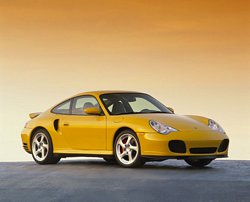ATLANTA – Not since the days of the legendary Porsche 930 has
Porsche offered a turbocharged cabriolet… until now. For the 2004
model year, the new Porsche 911 Turbo Cabriolet takes its place
beside the awesome Porsche 911 Turbo Coupe in the company’s model
lineup.
From 1987 to 1989, the Porsche 930, as the first Turbo was
code-named within the company, set milestones in the history of
open-air sports cars. That original Porsche 930 Turbo Cabriolet had
a 3.3-liter horizontally opposed “boxer” six-cylinder engine
with only two valves per cylinder, yet it produced 300 horsepower
and could sprint from a standing start to 62 mph (100 km/h ) in only
5.2 seconds on its way to a top track-test speed of 161 mph (259
km/h).
|
Specifications |
|
Engine |
|
Flat-6,
Twin-turbo |
|
HP |
415 BHP @
6000 rpm |
|
Displacement |
219.4 CI /
3596 CC |
|
Torque |
415 lb-ft @
2700-4600 rpm |
|
Weight |
3659 lb
(1660 kg) |
|
Acceleration 0-60 mph |
4.2 sec. |
|
Top speed |
189 MPH /
304.2 KPH |
|
Driveline |
-- |
|
Price (approx) |
Starting at $128,000 |
For 2004, the new Porsche 911 Turbo Cabriolet draws its power
from the same 3.6-liter twin-turbocharged engine as the Porsche
Turbo Coupe, so it delivers 415 horsepower (SAE) and 415 lb.-ft. of
torque.
The 2004 Porsche 911 Turbo Coupe and Cabriolet are designed for
long-distance comfort as well as high performance, with equipment
such as a Bose® digital audio system, leather seating and available
features like the Porsche Communication Management system with
navigation and a 5.8-inch color monitor.
The 2004 Porsche 911 Turbo Cabriolet comes with a fully automatic
three-piece top that opens in a Z-configuration and folds down into
a compartment behind the rear seat. Unlike most cabriolet tops that
expose the inside of the roof lining when the top is retracted,
Porsche’s Z-configuration keeps the inside of the roof protected
at all times, takes up less space when the top is stowed, and
provides better protection for the heated rear glass window when the
top is down.
The Cabriolet top is made of a high-quality fabric, with a special
plastic material between the outer and inner layers providing
superior sound insulation and heat protection.
A light but stable aluminum frame helps keep the structure stable
and resistant to ballooning, even at very high speeds, and applies
tension to the section of the roof between the windshield and the
first bracket. The top has been tested in a wind tunnel at speeds of
nearly 210 mph (338 km/h) without problems.
The roof is fully automatic, operated by a hydraulic system and
electric motors that lock the front roof bracket to the windshield
frame. A microcomputer masterminds the smooth flow of all functions
that opens and closes the top in 20 seconds.
All 2004 Porsche 911 Turbo Cabriolets come with both a standard wind
deflector and an aluminum hard top. The wind deflector, made of two
frames covered by a net fabric, extends over the area between the
front seats and the supplemental safety bar cover and ensures a
draft-free driving experience when the top is down. The wind
deflector can be installed or removed in a matter of seconds and can
be stored in the front luggage compartment.
The aluminum hard top is made from two shells riveted together and
includes a parcel shelf that helps reinforce its structure. The hard
top has a heated rear glass window, yet weighs only 71 pounds (32
kg), making it easy for a driver and passenger to install when they
want the security of a hard roof over their heads.
Whether the hardtop is installed or the soft top is up or down, the
Porsche 911 Turbo Cabriolet provides outstanding protection for its
occupants. The car has two supplemental safety bars that are
discreetly hidden behind the rear seats. Should one of the angle
sensors detect the imminent risk of the car rolling over, the safety
bars automatically deploy.
The 911 Turbo Cabriolet body shell was developed along with the body
of the new 911 Carrera 4S Cabriolet and has substantial
reinforcements to maintain its safe, stiff structure even without a
top. Three-dimensional junction plates are integrated into the side
sills and so-called shaft reinforcements, which are welded and
bonded, are integrated behind the B-pillars to provide even more
strength.
Providing such additional reinforcements was no easy job for
Porsche’s development engineers, since the intake openings for the
Turbo’s intercooler are located at exactly this point on the sides
of the car, and the mechanical and electrical systems for the rear
side windows are fitted in this area. To achieve their goals,
Porsche’s engineers used high-strength steel.
The 2004 Porsche 911 Turbo Cabriolet is equipped with larger side
airbags designed to provide protection for the occupant’s head,
chest and hips in the event of a side impact, even when the roof is
open and the side windows are lowered.
Whether Coupe or Cabriolet, the 2004 Porsche 911 Turbo draws its
power and its name from its 3.6-liter horizontally opposed
“boxer” engine, which provides 415 horsepower (SAE) and 415
lb.-ft. of torque.
But, for 911 Turbo Coupe drivers who want even more power under
their control, an optional factory-installed X50 engine enhancement
performance package boosts the turbochargers’ pressure to generate
444 horsepower (SAE) and 457 lb.-ft. of torque.
Porsche began using turbochargers in the famed Porsche 917 racecar
in the early 1970s and introduced its first 911 Turbo production
model in 1974. The 911 Turbo arrived in the United States for
model-year 1976, and with its 234-horsepower (SAE) engine could
achieve 0-62 miles per hour (0-100 km/h) in 5.5 seconds.
|
|






